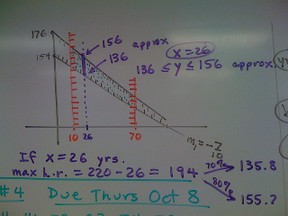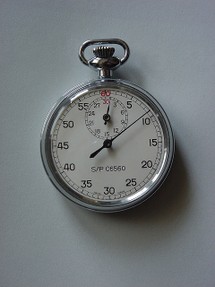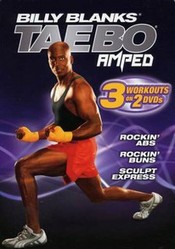
How to Exercise at a Good Heart Rate
by mikedehaan
You need to exercise at a good heart rate for successful cardiovascular fitness training. Here are some ways you can train at the right intensity.
Resting Heart Rate versus Pulse Rate when Exercising
How to Approximate Your Maximum Heart Rate
Every person’s heart rate changes during the day. Your pulse, or heart rate, depends on whether you are sitting, standing, walking or exercising; on your emotion state; and on your general health and cardiovascular fitness. Even an illness can raise your resting pulse rate while you are ill.
You achieve your absolutely lowest pulse rate while drowsing in bed; but most of us can simply sit quietly for a few minutes to find a restful heart rate.
When you stand and begin walking or running, your pulse goes up from the resting rate. The big questions are how high can it go, and how much work this will take?
Most people will have a maximum heart rate (MHR) based on their age: MHR = 220 minus age in years. This is a good approximation, but specific people might find that they have higher or lower values.
People have to exercise very intensely to reach their MHR, but luckily that’s not necessary for a cardiovascular fitness training program aimed at improving health.
Target Heart Rate During Exercise
How to Calculate your Target Heart Rate
A cardiovascular training program aims at raising your heart rate enough to force your body to improve, without killing you or making you stop from exhaustion before exercising at least 20 minutes.

A typical “cardio” program’s target is a pulse rate between 70% and 80% of your MHR.
Here are some specific examples. At age 30, Adam’s MHR is 220 minus 30, which equals 190 beats per minute. 70% of 190 is 133, and 80% of 190 is 152. So Adam’s target heart rate during exercise is the range from 133 to 152.
At age 45, Beth’s MHR is 220 minus 45, or 175. Her 70% to 80% range is 122 to 140.
Measuring Your Heart Rate during Exercise
Three Practical Choices and One for the Elite Athletes
Athletes have four choices if they want to know their heart rates during exercise. The first choice is to wear a personal, portable heart rate monitor. The second option is to stop and check your pulse from time to time. A third possibility is to learn to trust your breathing and internal sense of effort, as guides to your actual exertion. The fourth, and unlikeliest, is to be an elite athlete undergoing testing in a laboratory: enjoy wearing the wires and gas exchange mask, and good luck at the Olympics!

Heart Rate Monitors
Many runners train and race while wearing a personal heart rate monitor. Some models use a strap around the chest to detect the heart rate. That number is fed to a wristwatch, either through a wire or using a wireless radio signal. The most sophisticated units keep track of the heart rate during the session, and also beep when the athlete is outside the target training zone. (If she runs too fast, or too slowly, then her heart rate will be too low or too high for optimal training benefits. So the watch beeps its warning).
A similar portable heart rate monitor watch might also have a GPS (Global Positioning System) feature, to let the runner correlate her speed and total distance with her heart rate throughout her training session.
This is the best choice for the most accurate and timely way to monitor your heart rate while exercising. Check for sales prices, and be sure you keep the battery charged.
Check Your Pulse during Rest Breaks
Some training programs build rest periods into their training sessions; use these opportunities to check your pulse against your regular wrist watch that shows seconds ticking away.
Otherwise, check your pulse at the end of the main part of your session, but before the cool-down phase.
The best plan is to start as soon as possible after a sustained effort; your pulse might drop after ten or fifteen seconds. Only take your pulse for fifteen seconds, and then multiply by four to get your rate per minute.
Know Yourself and Your Breathing
Researchers have been surprised to find that most people are quite accurate when they say how intense their workout was. You should take your pulse during a few sessions, but also take note of your breathing and “how does it feel” as you exercise.
A great rule of thumb is the “talk test”. You should be able to carry on a conversation, although it may take two or three breaths for a sentence. “If you (gasp) take a breath (gasp) after just (gasp) a word (gasp) or two”, then you are past the 80% target. If you can sing and hold the long notes, you need to work harder to make the 70% grade.
Words of Warning for Exercise Programs
Take Caution before Taking Exercise
Check with your doctor before starting any exercise program. Start slowly, only working out every other day. Keep both the duration and the intensity low, especially as you start. Increase the duration by 10% a week, and only if it’s comfortable.

People with pre-existing conditions such as heart problems or diabetes have special reasons to get their doctor’s advice.
Disclaimer: The information contained in this article is for educational purposes only and should not be used for diagnosis or to guide treatment without the opinion of a health professional. Any reader who is concerned about his or her health should contact a doctor for advice.
You might also like
The Insanity Workout Program: This 40-Something's Personal Exp...The Insanity Workout Program is popular with home exercise enthusiasts lookin...
Boot Camp Workout DVDsIf you love working out at home and enjoy using workout DVDs, then you will l...



 When a Senator's Wife was Tossed from a Planeon 09/07/2012
When a Senator's Wife was Tossed from a Planeon 09/07/2012
 Air, Table Salt and Water in a Home Experiment about Marson 03/06/2012
Air, Table Salt and Water in a Home Experiment about Marson 03/06/2012
 The Mike DeHaan Wizzographyon 12/30/2011
The Mike DeHaan Wizzographyon 12/30/2011


Comments
Very helpful advice here! I'm supposedly supposed to max out at 195 but that's usually where I find myself to be when I'm working out. Not sure if that's a good thing or bad thing, that's just how it always ends up being.